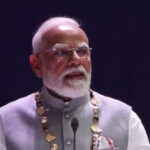protocol
Chairman of the occasion, distinguished guests, ladies and gentlemen.
First of all I would like to express my deep gratitude to the author, Dr. Dakuku Peterside, for the great honor of inviting me to review this remarkable book. Standing here today is not just a privilege; It is also a humbling responsibility to engage in work that will, without question, shape the way leaders think and practice leadership in our time, when the storms of life and history come before them.
I have been asked to review this great body of knowledge titled “Leading in a Storm: Practical Leadership Strategies in Crisis Situations” published by Safari Books.
Sir, thank you once again for entrusting me with this task. It's one thing to review a book; It is quite another to review a book of such depth, breadth and timeliness. It is a book, a well-researched project, a mirror, and a call to action. And it could not come at a more urgent time in our national and global journey.
The book is divided into nine chapters, each exploring a specific competency of crisis leadership. I must say that the work done here is practical and narrative-driven, research-informed and case-rich; It truly blends academic insights with lived experience and theory with application. And each chapter flows into key points and reflection questions, designed to elicit growth and learning. I am particularly excited that it is rooted in African contexts yet coordinated globally; It connects leadership theory to local realities. From a literary perspective, it is written in clear, instructional prose that combines storytelling, strategy, and scholarship into one intuitive experience. Is quite rich.
image.png
Why does this book matter now?
We live in a world where crises are no longer occasional interruptions; They have become recurring leadership positions. Whether it's economic instability, pandemics, political unrest, or institutional breakdown, today's leaders are constantly being pushed into the center of chaos.
The author's initial question in the introduction is very interesting.
“Imagine being thrust into the center of chaos: no warnings, no rulebook, and no guarantees. You're the pilot in the air when there's three hours of continuous turbulence. Protests break out in whatever sector you work in. A port director is facing a global supply chain disaster. The captain of a ship that's sinking. A mayor is facing a citywide blackout with his livelihood at stake. What will you do?”
“…leaders who succeed are not those who avoid crisis, but those who have learned to face it with skill and confidence.”
It reminds us that crises are not just problems to be managed. They are the crucible that tests, refines, and reveals leadership. These are the moments when leaders must demonstrate not only competence, but also character; Not just ability, but courage.
This is why I believe the book is not just relevant; it is inevitable.
intellectual core of the book
Dr. Peterside has distilled five years of rigorous research into a clear and practical framework of eight core competencies that enable leaders and organizations to perform effectively under intense pressure.
These eight competencies are:
1. Contextual Intelligence – The ability to read situations accurately.
2. Quiet confidence – the composure that steady others.
3. Meaning-making – bringing clarity from confusion.
4. Strategic Decision Making – Choosing wisely under pressure.
5. Clear communication—use words to unite, not divide.
6. Strategic flexibility – Adaptation to changing circumstances.
7. Coordination of teamwork – aligning diverse actors.
8. Facilitating learning – ensuring we don't waste a crisis.
What impresses me here is not only the clarity of the framework but also its architecture. Notice how he begins by building on contextual intelligence: Before you can act, you must first see and understand. From there, he develops emotional, cognitive, and social skills that, when combined, give leaders the agility to stand tall without getting swept away in the storm.
And these are not presented as a checklist. The book shows how they depend on each other; Quiet confidence enables clear communication, meaning-making promotes flexibility, and teamwork inspires effective learning.
The authors emphasize that crisis leadership is not a mysterious talent that some people are born with and others cannot achieve. It is a set of learnable skills, a way of thinking that can be developed, behaviors that can be practiced and refined, and the belief that we can have a fundamentally different relationship with uncertainty. Instead of seeing a crisis as something to be feared and avoided, we understand it as something that can be dealt with with skill and purpose.
What makes this book compelling again is the vivid historical narrative and case studies.
In the tense hours following the assassination of Chris Hani, we meet Nelson Mandela, who was exemplifying peace and using rhetoric to pull the country back from the brink of civil war.
We meet Luis Urzúa, a shift foreman during a Chilean mine disaster, whose steady leadership transformed panic underground into purposeful cooperation.
We consider the entertainers aboard the sinking Oceanos cruise ship, who became unexpected leaders by boosting morale when the official captain abandoned ship.
And closer to home, we examine responses to Ebola in Liberia, protests like #FeesMustFall in South Africa, and even our own national crises in Nigeria.
The stories are asking the obvious question: What would you do if you were caught in one of these storms?
When the author identifies preparing for an event that has not yet happened, making quick decisions when the unexpected occurs, and taking decisive action to meet unexpected challenges as the core of crisis leadership, he is in for a shock.
To these, I would add one more thing: Mindful Leadership – Emphasizing on developing your internal environment to deal with external aggression. True leadership power is built within; It is the discipline of mastering one's emotions, mindset, and energy so that the chaos outside does not distort the clarity within.
Practical Values for Leaders
The author did not leave us at the level of theory. Each chapter ends with reflection questions, exercises, and strategies. This makes the book worth reading and practicing.
A policy maker, a CEO, a military officer, or even a student leader can close each chapter with actionable insights they can start working on immediately.
It is, in many ways, a training manual disguised as a book.
a gentle suggestion
If I could add one gentle suggestion, I believe the book would benefit from a one-page executive toolkit: a distilled checklist or decision tree that leaders can keep in their pocket or pinned to their desk for quick reference amid the storm. All material is present in the chapters; Condensing it into one ready-to-use tool will make it even more powerful for busy practitioners.
I agree that the privileged position of being a reviewer is a decorated title for the Chief Opinion Officer to answer the biggest question of the night – What do I think about this book?
I think it's a rare mix: empirically rigorous, richly illustrated, and insistently practical. It speaks not only to academics, but also to practitioners. It is rooted in African realities yet global in its lessons.
And I am glad that my sentiments have been echoed by other phenomenological experts who confirm the relevance of the book in these turbulent times. From Loran Nordegren, who describes it as a blueprint for dealing with crises in technology, politics, and the environment, to Andrew Sykes, who calls it essential reading for the modern leader moving from one crisis to the next. Philip Hamm highlights its powerful insights, stories and tools for adapting and leading with confidence, while Dr Toye Sobande appreciates its contextual basis in Africa and its emphasis on peace, communication and clarity in chaos. For Harvard's Hugh O'Doherty, it is a practical manual for leading through uncertainty, and Prof. Tunji Olaopa aptly sums up its essence as a decisive contribution to the development of crisis leaders that the world so desperately needs today.
Dr. Peterside, I thank you again for this gift to the world of leadership. Your work will empower a generation of leaders to stand tall not only when the weather is fine, but when the storms are at their fiercest.
And so, ladies and gentlemen, I commend you all for leading us into a storm. Read this. Consider this. Practice it. Because storms will come, but with the right skills, we can all learn to not only survive them but also deal with them.
Thank you.











